A soundwalk is any excursion whose main purpose is listening to the environment. Today I was joined by Brian, a friend, composer, sound engineer, and educator. The sound collage below roughly represents a few of the auditory sensations along our path through the Sculpture Garden. (And just like in real life, some of these sounds are soft and others a little louder...)
Above: YouTube media by waitingline
Above: Vimeo media by Maureen Mcsmith
Above: YouTube media by jkontrad
Above: YouTube media by Greg Holmes of thelope.com
Above: YouTube media by yaaren
What: Part of our process was imagining how the Walker's sound environment changes through the seasons. For example, by late July, the Red-Winged Blackbirds don't sound like this anymore. A detailed map of our soundwalk is available here, with descriptions at each placemarker. If you're interested in trying a soundwalk on your own, here is a suggested 'score' I adapted from an essay by Hildegard Westerkamp. Additional thanks to Frauke Behrendt for support and resources.
Where: Minneapolis Sculpture Garden
Observers (Listeners): Abbie and Brian
Date/Time: Friday, July 29, 10 to 11 am
Conditions: Hot, sunny, sonic
Friday, July 29, 2011
Simulated Soundwalk
Labels:
auditory,
awareness,
change,
collaboration,
education,
expansive,
learning,
mapping,
speculation,
unseen
Tuesday, July 26, 2011
Median: No Man's Land or Guerilla Garden
 | |||
| Abbie in the 'median garden' Photo by Christina |
Where: Median between Hennepin and Lyndale Avenues (see the Walker in the background)
Observers: Christina and Abbie
Date/Time: Tuesday, July 26, about 3 pm
Conditions: Sunny, hot, traffic
Rumor has it these sunflowers are non-conformists, the rogue plantings of horticultural vandals. The next median to the north (behind me in the photo) is uniformly planted with tall grasses, evidence of some management plan though I don't know the details.
If you know the dirt on medians, roadsides, highway clover-leafs, or the centers of round-abouts, and the powers that battle over these marginalized territories, please do tell! Broadcast your comments here.
Labels:
anticipation,
collaboration,
human intervention,
locality,
maturation,
speculation
WAS // NOW
On my bike ride to work this morning, I made a short list of how things were but are no longer:
- Dock weed
- was: green flower stalks . . .
- now: rusty spindles
- Canada thistle
- was: flowering . . .
- now: almost all gone to down
- Bee balm
- was: unnoticed . . .
- now: beautiful pale violet blossoms
- Cow parsnip
- was: green umbels with seeds forming . . .
- now: umbels are brown in color
- Clovers
- was: in June, only white clover flowers
- now: by July, the purple clovers complement the scenery
Labels:
change,
continuity,
development,
ephemerality,
maturation
Monday, July 25, 2011
Purple, Past and Present
|
|
Where: General observations of urban landscapes (Bee balm noticed in Loring Park, at the edge of the wetland area; thistle flowers in road medians and along the edge of Loring Park's pond; crown vetch along the highways)
Observer: Abbie
Date/Time: Monday, July 25, 12:30 pm
Conditions: Inconstant and colorful
Saturday, July 23, 2011
By light of luciferin and luciferase
Though this post strays far afield from my Walker-centric focus, it merits mention because fireflies, to me, are the very symbol of fleeting summer. Their bioluminescence results from the reaction of two chemicals, luciferin and luciferase. Let this be a challenge to you to venture outdoors in the evening to spot these insects that are homely by day and hypnotic by night.
Where: Waseca airport
Observer: Abbie, Scott, Emily
Date/Time: July 22 evening into night
Conditions: Mosquitoey
Above: Vimeo media by John Dunstan
What: FirefliesWhere: Waseca airport
Observer: Abbie, Scott, Emily
Date/Time: July 22 evening into night
Conditions: Mosquitoey
Monday, July 18, 2011
Grackle Vernacular
Above: YouTube media by laynie0705
What: Since it is World Listening Day I make extra efforts to notice the sonic qualities of Garden ongoings. I hear young Common Grackles vocalizing. Watching them, I see they are begging food from their parents. It looked like what you see above, but with lots more needy pleading.
Where: West edge of the Sculpture Garden, by FlatPak House
Observer: Abbie
Date/Time: July 18, 8:10 am
Conditions: Warm, sunny
What: I hear a sudden squawk and it focuses my attention to a clash in a low tree branch. A few Cedar Waxwings get the message that they're not wanted here and fly away. I may have missed them entirely had it not been for the noisy complaint of the Common Grackle.
Where: West edge of the Sculpture Garden, by FlatPak House
Observer: Abbie
Date/Time: July 18, 8:15 am
Conditions: Warm, sunny
Sunday, July 17, 2011
"Now I will do nothing but listen. . . . I hear all sounds running together, combined, fused or following, sounds of the city and sounds out of the city, sounds of the day and night. . ."
St. Mary's Basilica bells, YouTube media by Markitectonic
If you say hello to me tomorrow morning between 8 and 8:30 am, I won't reply. But I'll most certainly hear you because I'll be engaged in a soundwalk. What is a soundwalk? Jim Cummings, founder of the Acoustic Ecology Institute, defines it as follows:
Walt Whitman
St. Mary's Basilica bells, YouTube media by Markitectonic
If you say hello to me tomorrow morning between 8 and 8:30 am, I won't reply. But I'll most certainly hear you because I'll be engaged in a soundwalk. What is a soundwalk? Jim Cummings, founder of the Acoustic Ecology Institute, defines it as follows:
At its simplest, a soundwalk is just what its name implies: a walk during which you simply pay attention to each sound you encounter. More complex variations can include seeking out the most distant sound audible, or the faintest. Soundwalks are just as interesting in cities as in nature, and indeed, urban acoustic ecology offers many points for reflection and even aesthetic appreciation.
Saturday, July 16, 2011
Flowering virginia creeper
Yet another observation from my weekend wanderings. There's probably flowering Virginia creeper to be found around the Walker, perhaps in Loring Park.
What: Flowering Virginia Creeper. The image to the left zooms in on this inconspicuous flower.
Where: Shakopee, MN
Observer: Abbie
Date/Time: July 16, 12 noon
Conditions: Sunny, humid, hot
 |
Virginia Creeper flower & buds Photo by Derek Lilly |
 |
Virginia Creeper foliage Photo by J. C. Lucier |
What: Flowering Virginia Creeper. The image to the left zooms in on this inconspicuous flower.
Where: Shakopee, MN
Observer: Abbie
Date/Time: July 16, 12 noon
Conditions: Sunny, humid, hot
Friday, July 15, 2011
A study in green
The color green can look remarkably vibrant in rainy conditons. Today's report comes from that chromacentric point of view.
General observation for today: Birds were abundant. Those on the ground busied themselves by foraging (gorging?), and those perched were entirely preoccupied with preening. My complete bird list for the day: Northern Cardinal, White-breasted Nuthatch, Rock Pigeon, American Robin, Green Heron, House Finch, Red-winged Blackbird, Mourning Dove, Common Grackle
 |
Photo by Len Blumin What: A Green Heron. With the rain and poor lighting, I couldn't get a good shot, so I borrowed this stunning image from a fellow Flickr photographer. I observed it for few minutes, during which it ceaselessly preened itself. This sighting isn't ephemeral or critical to phenology, but it was fun to see in an urban park. Where: Perched about 15' high in a pine tree, on the eastern edge of the Garden, a lot of traffic noise coming from Hennepin Avenue. Observer: Abbie Date/Time: July 15, 10:35 am Conditions: On-and-off rain, humid, low-hanging clouds obscuring the city skyline. |
 |
What: A Japanese beetle, about 3/8" in length. Kinda' pretty but totally pesky! This observation is a good phenological marker, as you can see from this diagram of the Japanese beetle's life cycle. Where: Water's edge at Spoonbridge and Cherry. Observer: Abbie Date/Time: July 15, 10:20 am Conditions: Wet but not raining |
 |
What: Green grass and a troop of mushrooms. Or are these gregarious? Mushrooms in a close group (but not so close as to be a cluster) are said to be a troop. If the group is more scattered and irregular, they are said to be gregarious. Eager for more vocabulary for fungi growth habits? Check it out: http://www.mushroomthejournal.com/greatlakesdata/Terms/troop269.html Where: Open Field, north edge along Vineland Place Observer: Abbie Date/Time: July 15, 10: 45 am Conditions: Good for growing |
Thursday, July 14, 2011
Hey, listen up!
World Listening Day is next Monday, July 18. To participate, I'm planning a 30-minute soundwalk at 8 am, starting at FlatPak House. This is a pilot experience to inform the "Soundwalk Listening Experiment" planned for July 29. I've posted some resources about outdoor listening and acoustic ecology on this site's Soundwalk Page.
Tuesday, July 12, 2011
Cicada, droning unseen
| What: Cicada song, probably a 'dog day cicada.' (No, this isn't my field recording. This audio is a different species, Tibicen auriferus, courtesy the outstanding library of cicada recordings at InsectSingers.com.) Where: W 22nd St between Garfield and Harriet Avenues Observer: Abbie Date/Time: July 12, 5:50 pm Conditions: Sunny, warm, pleasant |
Cicada? Ah, summer! [. . .on to the next thought. . .]But with the Open Phenology mindset, my awareness behaves differently:
Cicada? And it's... July 12! Hey, isn't that the first I've heard this year? [inventorying recent memory...] No, no, none yet—I would have noticed. Will it sing again? Only that once? Eventually, (when, do you think?) the cicada chorus will be a regular feature of the summer afternoon sounds. Late summer, that is. Sigh...
Monday, July 11, 2011
Dock Swatch
Inspired by an observation the Open Phenology group made last Friday, I collected specimens to create this "dock swatch." As the plants' flower spires turn rusty in color, you'll spy this 'weed' proliferating on banked sides of highways.
Friday, July 8, 2011
You gonna' eat that?
Open Phenology collaborator Sarina was our guide to the veritable supermarket of the urban Loring Park.
Photos, left to right: Pepperweed by Dan Mullen; Dock weed by Abbie; Wood sorrel by Judi Cox; Arrowhead by Dave
Thinking of plants in these terms (edible/non-edible) must play a role in learning, because Sarina was identifying plants left and right, up and down, and sharing this knowledge with other eager participants.
Care to join us for dessert? Perhaps later this season we'll harvest some goldenrod galls. Here's a fact that's hard to believe (but easy to remember): Inside each gall is a larval fly absorbing sugar from the plant, and if you get it at the right time of year, it's a sweet treat! That's right—to eat!
 |
| Pepper/Spice? |
 |
| Cereal? |
 |
| Tangy greens? |
 |
| Duck Potato? |
Thinking of plants in these terms (edible/non-edible) must play a role in learning, because Sarina was identifying plants left and right, up and down, and sharing this knowledge with other eager participants.
Care to join us for dessert? Perhaps later this season we'll harvest some goldenrod galls. Here's a fact that's hard to believe (but easy to remember): Inside each gall is a larval fly absorbing sugar from the plant, and if you get it at the right time of year, it's a sweet treat! That's right—to eat!
What else did the ten of us see today? Click here to review some of our observations.
Labels:
adaptation,
collaboration,
collectivity,
education,
learning
Guest Blog: Scott Artley joins in on July 8th

On the morning of July 8th, seven people stood at the FlatPak House on the West end of the Minneapolis Sculpture Garden, looking much like some of the other tourists wandering through the area. Only instead of capturing photos of artworks, they donned binoculars to catch a momentary glance of birds. Instead of maps filled with the names of public artists, they held pocket-sized plant identification handbooks and ornithology guides.
Abbie greeted us and explained the concept of phenology: the study of the natural world through the seasons, seeking markers of time and change. It’s a science requiring sustained attention to subtlety—an artistic eye is an asset to environmental inquiry. Abbie’s mantra during the excursion was simple: “What do you notice?”
Although I went to Open Phenology to learn about the natural world around the Walker Art Center campus, I found myself fascinated by the way this group became a community as we wandered over the Whitney Bridge into Loring Park. Although Abbie’s is the only Open Field project that engages with the world of science, it does demonstrate aspects familiar to other Open Field activities:
- the facilitation of curiosity
- an ongoing commitment of time and space to step out of the everyday, and
- the ultimate outcome of sharing an experience together.
Thanks for inviting me along, Abbie, I’m looking forward to joining again.
--Scott Artley
Open Field Coordinator and Open Phenology guest blogger
Open Phenology print by Abigail Woods Anderson
Labels:
awareness,
collaboration,
collectivity,
education,
interrelatedness,
learning,
subjectivity
Cheetah-bug!
 |
| July 8, 11:30 am: Dragonflies animate the field |
Where: Walker Open Field—iron stakes and caution tape protect the new sod. Scanning the perimeter, every stake is claimed by a dragonfly. What could be the reason? Heat? Vantage point? I must have seen 20 individuals and I wondered if they would be around at all if not for the stakes offering a feature on the landscape.
Observer: Abbie
Date/Time: July 8, 11:30 am
Conditions: Hot, slight breeze
Wednesday, July 6, 2011
The Savanna Syndrome
 |
| July 6, 9 am: A palette of new sod |
Labels:
adaptation,
human intervention,
interrelatedness,
locality
Saturday, July 2, 2011
Knee high by the Fourth of July
Once more, I'm expanding Open Phenology's micro-local focus, this time with a regionally relevant observation. While hiking at the Trout Valley Management Unit in Winona County, a stretch of path led me along a cornfield's perimeter. By my casual estimate, the plants measured up to the old adage, being "knee high by the Fourth of July." Modern agriculture typically surpasses this now-outdated benchmark, but this year's late spring was a setback for the crop's stature.
Turns out that 'knee high' is not a measurement of height. After a bit of research (the clickety-click Web surfing kind), I discover that it refers to a stage of the plant's maturity. Knee high corn is characterized by the sixth leaf's emergence from the stalk and the uppermost growth point's emergence above the soil surface. (Source: David Laatsch, as reported in the Watertown Daily Times)
I'll have to look more carefully next time!
Turns out that 'knee high' is not a measurement of height. After a bit of research (the clickety-click Web surfing kind), I discover that it refers to a stage of the plant's maturity. Knee high corn is characterized by the sixth leaf's emergence from the stalk and the uppermost growth point's emergence above the soil surface. (Source: David Laatsch, as reported in the Watertown Daily Times)
I'll have to look more carefully next time!
Friday, July 1, 2011
Constant Vigilance Post Script
Returning to my desk after Open Phenology, my colleague Scott Artley is thrilled to report a hawk seen soaring over the Sculpture Garden. And I recollect that yes, I heard what must have been a hawk's cry. But I was so preoccupied watching thirteen-lined ground squirrels and robins that I didn't look up. Come to think of it, I bet that hawk had the little ground animals in its sights, too!
Next Friday (July 8), Scott Artley will join Open Phenology. In hopes that the hawk might make another appearance, I'm studying the field marks and calls of a few likely species: Red-tailed Hawk, Sharp-shinned Hawk, and American Kestrel.
Post-post script: Here's something to ponder: Where are the grackles today? Usually (so far this summer, that is), Common Grackles are emphatically abundant in the garden, but today I didn't see them. Could it be the heat? Hmm...
Next Friday (July 8), Scott Artley will join Open Phenology. In hopes that the hawk might make another appearance, I'm studying the field marks and calls of a few likely species: Red-tailed Hawk, Sharp-shinned Hawk, and American Kestrel.
Post-post script: Here's something to ponder: Where are the grackles today? Usually (so far this summer, that is), Common Grackles are emphatically abundant in the garden, but today I didn't see them. Could it be the heat? Hmm...
Constant Vigilance!
I was chatting with my colleague Christina when I hit upon this truism: constant vigilance is the foundation of good phenological practice. Christina, catching the reference I unwittingly made, explained that Harry Potter's Professor Alastor "Mad-Eye" Moody employs this same motto of "Constant Vigilance!" to teach Defense Against the Dark Arts. But now back to my familiar domain, that of Muggles, Citizen Science, and natural phenomena in the Walker's vicinity. In my June 23 post, I anticipated seeing changes, these being among them:


What: Nasturtium flowering, leaf at ~5" diameter
Where: Arlene Grossman Memorial Arbor
Observers: Abbie (July 1)
Date/Time: May 27 (left) and about 10:20 am on July 1 (right)
Conditions: Sweltering heat (July 1)
What: American Robin juvenile. While these pictures document different individuals, the emphasis is on change over time (June 10 to July 1)—most noticeably, the development of functional flight feathers.The robin on the right, though about the same size as an adult, can be recognized as juvenile by the plumage. See the speckled breast?
Where: Sculpture Garden, by Scott Burton's Seat-Leg Table (July 1)
Observers: Abbie (July 1)
Date/Time: June 10 (left) and about 10:30 am on July 1 (right)
Conditions: Sweltering heat (July 1) (eighty-some degrees)
So, besides Alastor Moody and myself, who else might call for "constant vigilance?" A gardener, naturally. Not to battle the Dark Arts so much as to keep horticultural entropy at bay. On today's survey, I noticed a team of three gardeners tending to the arbor.
What: Iris leaves, tied in a knot and trimmed, to keep the garden looking orderly. And, in practical terms, this fastidious management allows light to reach the iris' neighbors
Where: Arlene Grossman Memorial Arbor
Observers: Abbie
Date/Time: July 1, about 10:15 am
Conditions: Sunny, hot (eighty-some degrees), and humid
What: Clematis—about 5' tall and flowering—trained with twine to climb the arbor
Where: Arlene Grossman Memorial Arbor
Observers: Abbie
Date/Time: July 1, about 10:15 am
Conditions: Sunny, hot (eighty-some degrees), and humid
Constant vigilance is hyperbole, of course, but it's something to strive for. Anticipation has a positive influence on awareness.Take for example the Como Park Zoo and Conservatory's corpse flower. Again, props to my colleague Christina who watched the flower webcam with steadfast attention and even made a timely pilgrimage to witness the rare bloom. My vigilance, on the other hand, faltered, and I'm kicking myself for missing it.
If you'd like to prepare for July in hopes of not missing out, here's a tool to help you anticipate: Jim Gilbert's phenology report for July 2010 (PDF, 416 kb).


What: Nasturtium flowering, leaf at ~5" diameter
Where: Arlene Grossman Memorial Arbor
Observers: Abbie (July 1)
Date/Time: May 27 (left) and about 10:20 am on July 1 (right)
Conditions: Sweltering heat (July 1)
What: American Robin juvenile. While these pictures document different individuals, the emphasis is on change over time (June 10 to July 1)—most noticeably, the development of functional flight feathers.The robin on the right, though about the same size as an adult, can be recognized as juvenile by the plumage. See the speckled breast?
Where: Sculpture Garden, by Scott Burton's Seat-Leg Table (July 1)
Observers: Abbie (July 1)
Date/Time: June 10 (left) and about 10:30 am on July 1 (right)
Conditions: Sweltering heat (July 1) (eighty-some degrees)
So, besides Alastor Moody and myself, who else might call for "constant vigilance?" A gardener, naturally. Not to battle the Dark Arts so much as to keep horticultural entropy at bay. On today's survey, I noticed a team of three gardeners tending to the arbor.
What: Iris leaves, tied in a knot and trimmed, to keep the garden looking orderly. And, in practical terms, this fastidious management allows light to reach the iris' neighbors
Where: Arlene Grossman Memorial Arbor
Observers: Abbie
Date/Time: July 1, about 10:15 am
Conditions: Sunny, hot (eighty-some degrees), and humid
What: Clematis—about 5' tall and flowering—trained with twine to climb the arbor
Where: Arlene Grossman Memorial Arbor
Observers: Abbie
Date/Time: July 1, about 10:15 am
Conditions: Sunny, hot (eighty-some degrees), and humid
Constant vigilance is hyperbole, of course, but it's something to strive for. Anticipation has a positive influence on awareness.Take for example the Como Park Zoo and Conservatory's corpse flower. Again, props to my colleague Christina who watched the flower webcam with steadfast attention and even made a timely pilgrimage to witness the rare bloom. My vigilance, on the other hand, faltered, and I'm kicking myself for missing it.
If you'd like to prepare for July in hopes of not missing out, here's a tool to help you anticipate: Jim Gilbert's phenology report for July 2010 (PDF, 416 kb).
Subscribe to:
Posts (Atom)






